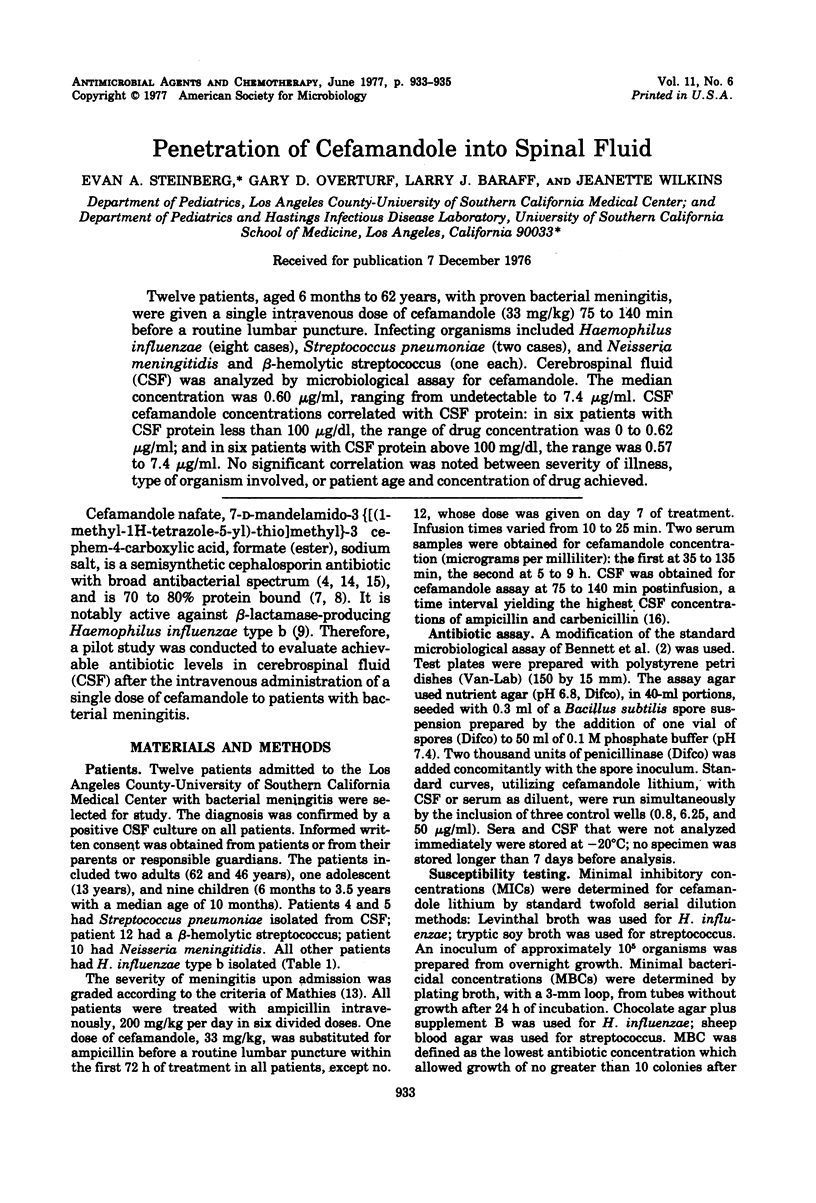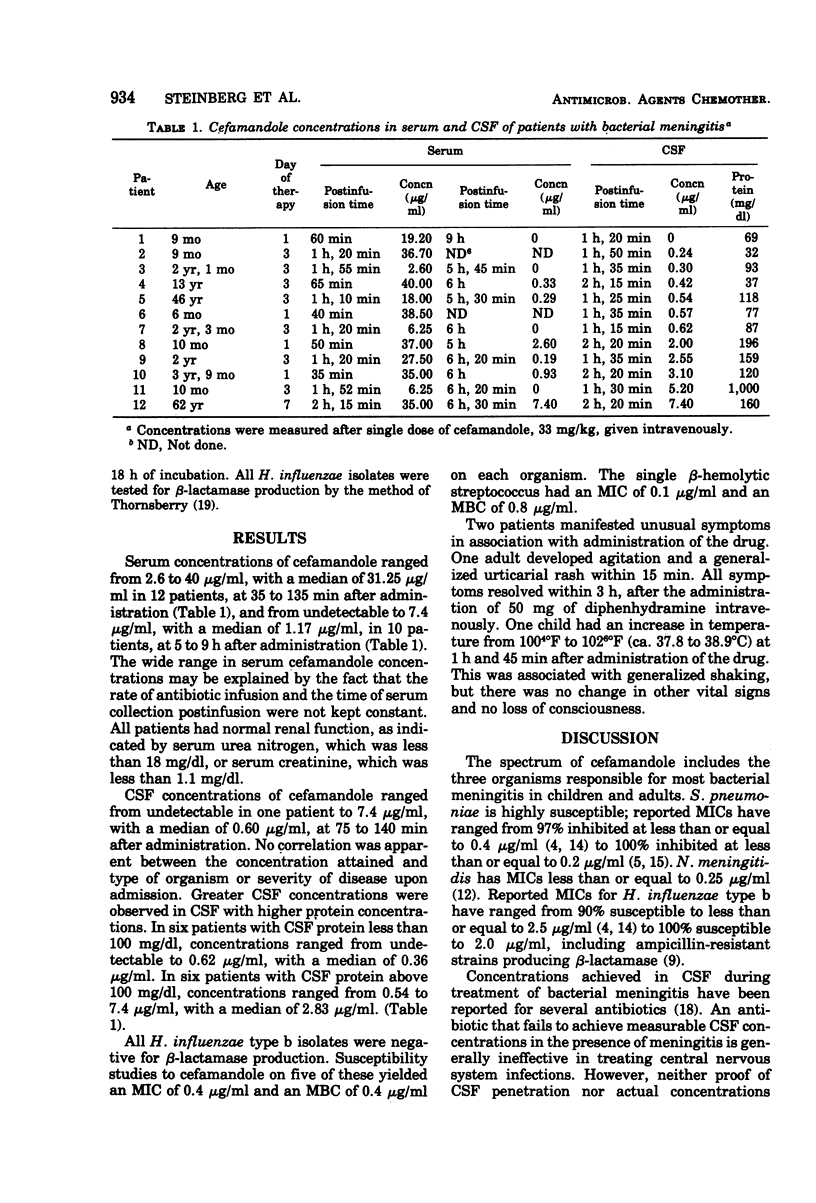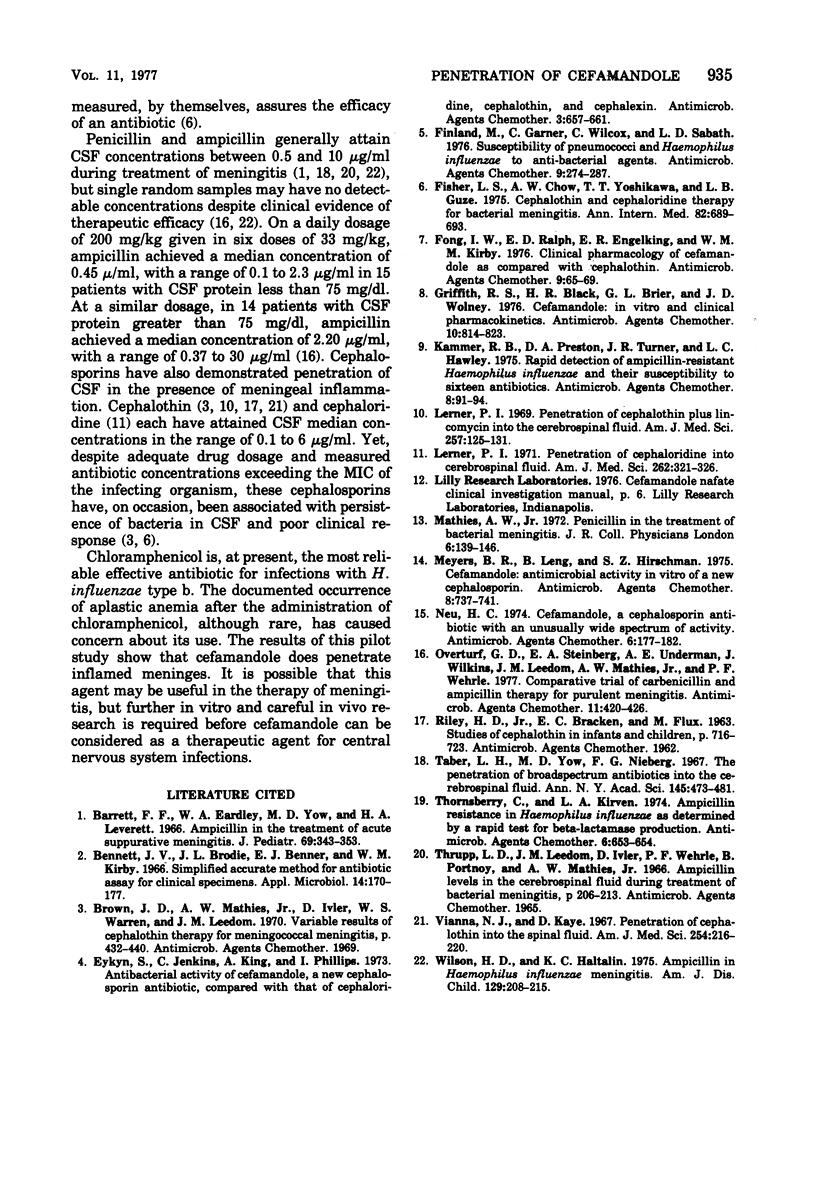Abstract
Twelve patients, aged 6 months to 62 years, with proven bacterial meningitis, were given a single intravenous dose of cefamandole (33 mg/kg) 75 to 140 min before a routine lumbar puncture. Infecting organisms included Haemophilus influenzae (eight cases), Streptococcus pneumoniae (two cases), and Neisseria meningitidis and β-hemolytic streptococcus (one each). Cerebrospinal fluid (CSF) was analyzed by microbiological assay for cefamandole. The median concentration was 0.60 μg/ml, ranging from undetectable to 7.4 μg/ml. CSF cefamandole concentrations correlated with CSF protein: in six patients with CSF protein less than 100 μg/dl, the range of drug concentration was 0 to 0.62 μg/ml; and in six patients with CSF protein above 100 mg/dl, the range was 0.57 to 7.4 μg/ml. No significant correlation was noted between severity of illness, type of organism involved, or patient age and concentration of drug achieved.
Full text
PDF


Selected References
These references are in PubMed. This may not be the complete list of references from this article.
- Barrett F. F., Eardley W. A., Yow M. D., Leverett H. A. Ampicillin in the treatment of acute suppurative meningitis. J Pediatr. 1966 Sep;69(3):343–353. doi: 10.1016/s0022-3476(66)80076-8. [DOI] [PubMed] [Google Scholar]
- Bennett J. V., Brodie J. L., Benner E. J., Kirby W. M. Simplified, accurate method for antibiotic assay of clinical specimens. Appl Microbiol. 1966 Mar;14(2):170–177. doi: 10.1128/am.14.2.170-177.1966. [DOI] [PMC free article] [PubMed] [Google Scholar]
- Eykyn S., Jenkins C., King A., Phillips I. Antibacterial activity of cefamandole, a new cephalosporin antibiotic, compared with that of cephaloridine, cephalothin, and cephalexin. Antimicrob Agents Chemother. 1973 Jun;3(6):657–661. doi: 10.1128/aac.3.6.657. [DOI] [PMC free article] [PubMed] [Google Scholar]
- Finland M., Garner C., Wilcox C., Sabath L. D. Susceptibility of pneumococci and Haemophilus influenzae to antibacterial agents. Antimicrob Agents Chemother. 1976 Feb;9(2):274–287. doi: 10.1128/aac.9.2.274. [DOI] [PMC free article] [PubMed] [Google Scholar]
- Fisher L. S., Chow A. W., Yoshikawa T. T., Guze L. B. Cephalothin and cephaloridine therapy for bacterial meningitis. Ann Intern Med. 1975 May;82(5):689–693. doi: 10.7326/0003-4819-82-5-689. [DOI] [PubMed] [Google Scholar]
- Fong I. W., Ralph E. D., Engelking E. R., Kirby W. M. Clinical pharmacology of cefamandole as compared with cephalothin. Antimicrob Agents Chemother. 1976 Jan;9(1):65–69. doi: 10.1128/aac.9.1.65. [DOI] [PMC free article] [PubMed] [Google Scholar]
- Griffith R. S., Black H. R., Brier G. L., Wolny J. D. Cefamandole: in vitro and clinical pharmacokinetics. Antimicrob Agents Chemother. 1976 Nov;10(5):814–823. doi: 10.1128/aac.10.5.814. [DOI] [PMC free article] [PubMed] [Google Scholar]
- Kammer R. B., Preston D. A., Turner J. R., Hawley L. C. Rapid detection of ampicillin-resistant Haemophilus influenzae and their susceptibility to sixteen antibiotics. Antimicrob Agents Chemother. 1975 Jul;8(1):91–94. doi: 10.1128/aac.8.1.91. [DOI] [PMC free article] [PubMed] [Google Scholar]
- Lerner P. I. Penetration of cephaloridine into cerebrospinal fluid. Am J Med Sci. 1971 Dec;262(6):321–326. doi: 10.1097/00000441-197112000-00002. [DOI] [PubMed] [Google Scholar]
- Lerner P. I. Penetration of cephalothin and lincomycin into the cerebrospinal fluid. Am J Med Sci. 1969 Feb;257(2):125–131. doi: 10.1097/00000441-196902000-00006. [DOI] [PubMed] [Google Scholar]
- Mathies A. W., Jr Penicillins in the treatment of bacterial meningitis. J R Coll Physicians Lond. 1972 Jan;6(2):139–146. [PMC free article] [PubMed] [Google Scholar]
- Meyers B. R., Leng B., Hirschman S. Z. Cefamandole: antimicrobial activity in vitro of a new cephalosporin. Antimicrob Agents Chemother. 1975 Dec;8(6):737–741. doi: 10.1128/aac.8.6.737. [DOI] [PMC free article] [PubMed] [Google Scholar]
- Neu H. C. Cefamandole, a cephalosporin antibiotic with an unusually wide spectrum of activity. Antimicrob Agents Chemother. 1974 Aug;6(2):177–182. doi: 10.1128/aac.6.2.177. [DOI] [PMC free article] [PubMed] [Google Scholar]
- Overturf G. D., Steinberg E. A., Underman A. E., Wilkins J., Leedom J. M., Mathies A. W., Jr, Wehrle P. F. Comparative trial of carbenicillin and ampicillin therapy for purulent meningitis. Antimicrob Agents Chemother. 1977 Mar;11(3):420–426. doi: 10.1128/aac.11.3.420. [DOI] [PMC free article] [PubMed] [Google Scholar]
- Taber L. H., Yow M. D., Nieberg F. G. The penetration of broad-spectrum antibiotics into the cerebrospinal fluid. Ann N Y Acad Sci. 1967 Sep 27;145(2):473–481. doi: 10.1111/j.1749-6632.1967.tb50247.x. [DOI] [PubMed] [Google Scholar]
- Thornsberry C., Kirven L. A. Ampicillin resistance in Haemophilus influenzae as determined by a rapid test for beta-lactamase production. Antimicrob Agents Chemother. 1974 Nov;6(5):653–654. doi: 10.1128/aac.6.5.653. [DOI] [PMC free article] [PubMed] [Google Scholar]
- Vianna N. J., Kaye D. Penetration of cephalothin into the spinal fluid. Am J Med Sci. 1967 Aug;254(2):216–220. doi: 10.1097/00000441-196708000-00012. [DOI] [PubMed] [Google Scholar]
- Wilson H. D., Haltalin K. C. Ampicillin in Haemophilus influenzae meningitis. Clinicopharmacologic evaluation of intramuscular vs intravenous administration. Am J Dis Child. 1975 Feb;129(2):208–215. doi: 10.1001/archpedi.1975.02120390042009. [DOI] [PubMed] [Google Scholar]


